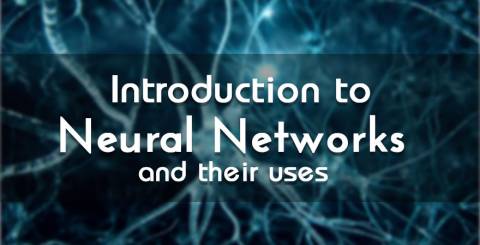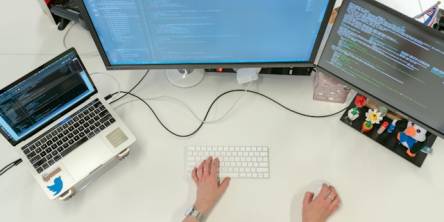What are Neural Networks Describe their Uses

An Artificial Neural Network is a model for processing information. It is inspired by the way our brain processes the information. The basic idea behind a neural network is to copy in a simplified but reasonably faithful way. There are a lot of densely interconnected brain cells inside a computer to learn things, make decisions, and recognize patterns in a human-like way. One of the most wonderful things of the neural network is that it does not need to be programmed, it learns all by itself through examples just like our brain does.
Neural network uses a very different approach to solve problems than conventional computers. The conventional computers use the algorithmic approach, which means the computer follows the set of instructions in order to solve a problem. The computer needs to be fed with a particular set of instructions to solve a problem. Without the instructions, it is not able to solve the problems. Where on the other hand, neural network process information in the same way as our brain does. The network is composed of highly interconnected processing elements called neurons, which works parallelly to solve a particular problem. In short, we can say that neural network learns from examples. They need not be programmed to perform a specific task. The examples must be selected carefully otherwise useful time will be wasted and the network might not work correctly.
A typical neural network has artificial neurons called units which vary in a range from few dozens to hundreds, thousands, or even millions. These units are arranged in a series of layers and each previous layer is connected to the next layer.
A neural network is divided into three parts or layers, which are Input Layer, Output Layer, and Hidden Layer. Input Unit is designed to receive various forms of information from external world so that the network will learn, recognize, or otherwise process. Other units lie on the opposite side of the network known as Output Unit. In between the output and input unit there lie one or more layers of Hidden Units, which together form the majority of the Artificial Brain. Most of the neural networks are fully connected, which means each hidden unit and each output unit is connected to every unit in the layer's either side.
Neural networks have a remarkable ability to derive meaning from complex or imprecise data that can be used to extract patterns and detect trends. these trends are too complex to be noticed by human or other computer techniques. A trained neural network can be regarded as an expert in information categorization if it has been given to analyze. This expert can be used to provide projections in new situations of interest and provide answers for questions. Neural Networks can also be used in the following fields:
Adaptive Learning: It includes the ability to learn how to perform the task based on the data provided for training or initial experience.
Organization: An artificial neural network can create its own organization or representation of the information received during learning.
Real-Time Operations: Artificial Neural Network’s computations can be carried out in parallel with special hardware devices.
Fault Tolerance due to Redundant Information Coding: Performance is degraded due to the Partial destruction of a network. However, some network capabilities may be retained even with major network damage.
Today the computing world has a lot to gain from neural networks. Their ability to learn by example makes them very flexible and powerful. Furthermore, there is no need to move to another algorithm in order to perform a specific task; i.e. there is no need to understand the internal mechanisms of the task. These are also very well suited for real-time systems because of their fast response and computational times which is due to their parallel architecture. Neural network also contributes to other areas of research such as neurology and psychology. They are regularly used to model parts of living organisms and to investigate the internal mechanisms of the brain. Therefore, we can say that neural networks do not perform miracles but if used sensibly they can produce some amazing results.
Similar Articles
The modern age of customers expect constant availability, no matter what the offer. And for that, the market requires rapid innovation cycles. In such a high stakes environment, technology infrastructure is more than just a cost center.
When evidence seals fail, cases weaken. Explore how compromised chain of custody can derail investigations and jeopardize justice.
Compare hydraulic and traction residential elevators to find the best fit for your home. Learn how each system works, their pros and cons, space needs, energy use, and maintenance requirements.
Extend the lifespan of your commercial marina docks with proactive maintenance. Learn essential inspection routines, material-specific care, and safety tips to protect your investment and ensure long-term dock performance.
Learn the key factors in designing an engineered fall protection system. Discover how hierarchy of controls, task analysis, structural integrity, and fall clearance ensure safety and compliance.
Today, modern businesses face constant pressure to operate with maximum efficiency. This requires a technology infrastructure that is both agile and robust. However, the traditional model of on-premises data centers often has significant limitations. These legacy systems can drain valuable resources from teams.
When people are hungry, standing in line for a table feels tiring and unpleasant. In fact, research shows that most individuals will just walk away if they have to wait longer. They will go and find another place to eat.
In the early stages of designing new community centers, fire stations and administration buildings, city planners and architects are forced to make a crucial decision: What building material is best suited for providing the most value, safety and longevity to the public?
Amazon Simple Queue Service (SQS), Simple Notification Service (SNS), and EventBridge are just a few of the messaging services that AWS provides to meet various demands when it comes to creating scalable and effective cloud systems.









